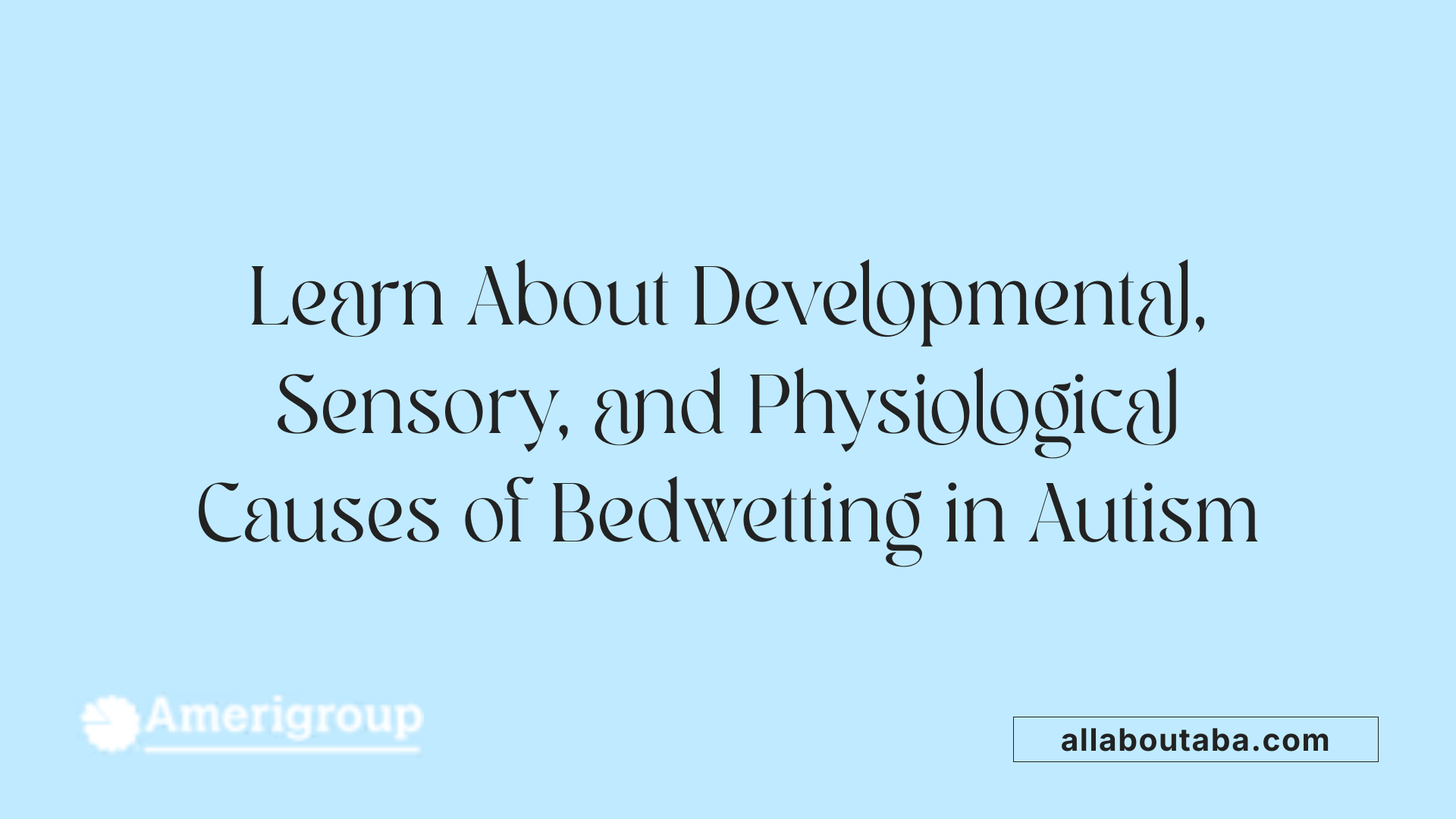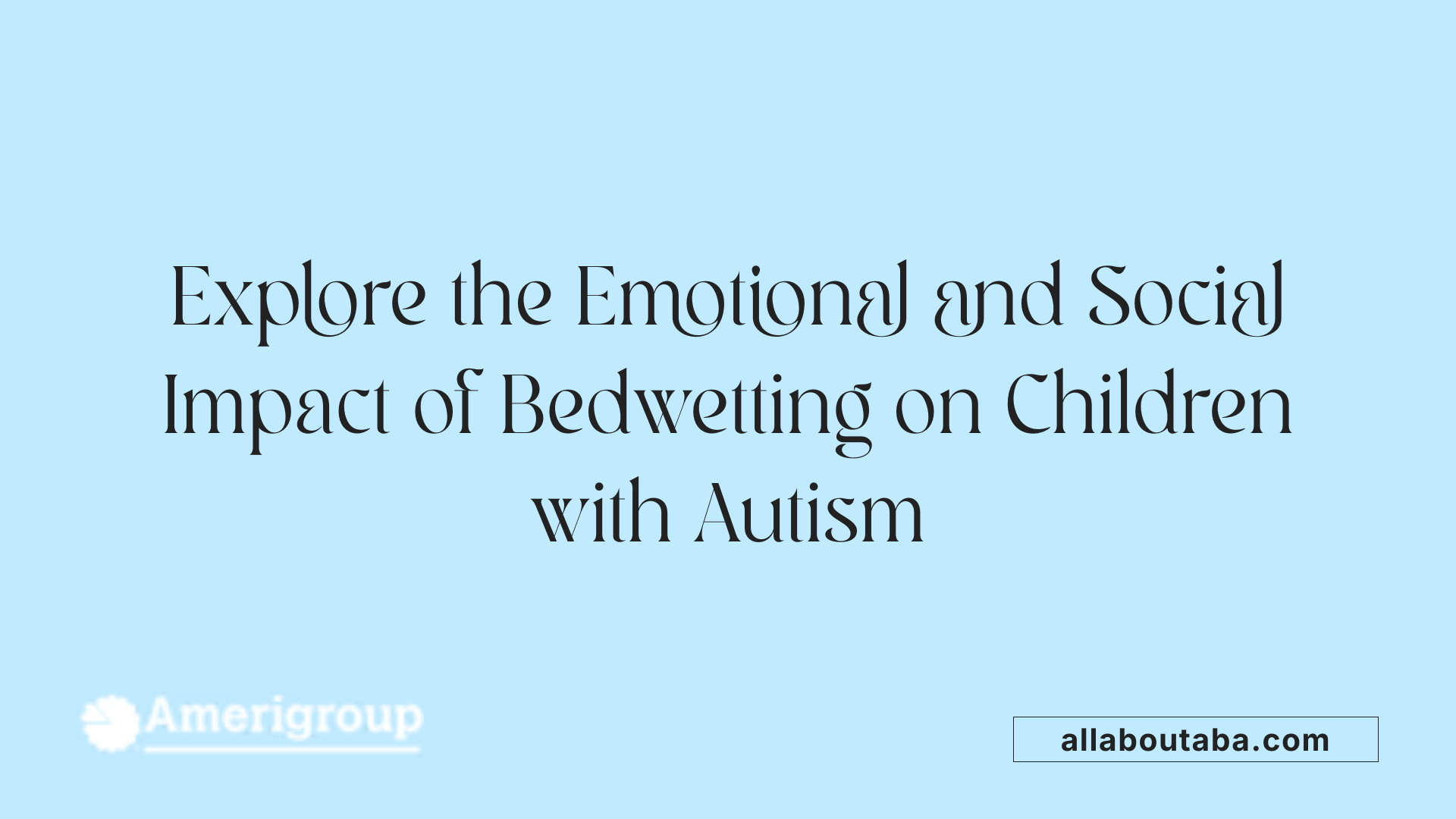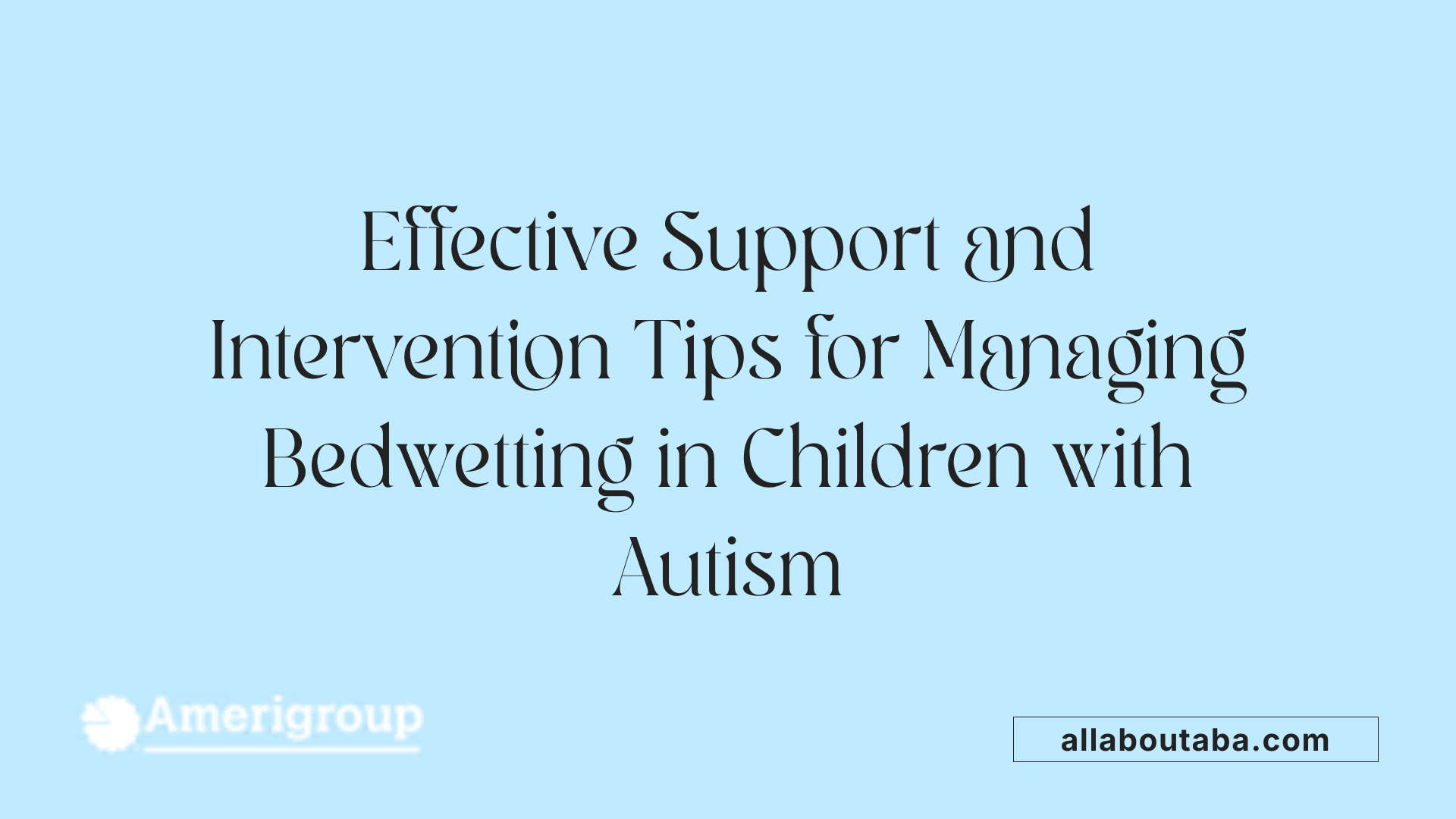Autism and Bed Wetting
Autism and Bedwetting: An Overlooked Connection
Bedwetting, or nocturnal enuresis, is a common concern among children with autism, impacting their emotional and physical well-being. Unlike typically developing children, those on the autism spectrum often experience prolonged bedwetting episodes that can persist into adolescence and adulthood. This article explores the complex relationship between autism and bedwetting, delves into the causes, effects, scientific insights, management strategies, and the importance of caregiver awareness, aiming to provide a comprehensive guide for families and professionals alike.
The Correlation Between Autism and Bedwetting
What is the relationship between autism and bedwetting?
Children with autism and ADHD are more often affected by bedwetting than their neurotypical peers. Research, including a study from the Journal of Pediatric Urology, reveals that around 30% of children with autism experience nocturnal enuresis, compared to virtually none in control groups. These children also tend to experience higher rates of daytime urinary incontinence, with about 25% affected, versus just under 5% in typically developing kids.
The reasons behind these differences are multifaceted. Children with autism often face developmental delays, sensory processing issues, and communication difficulties that can interfere with bladder control. Sleep disturbances are common, including conditions like sleep apnea and nightmares, which can deepen sleep and make waking for urination more difficult.
Moreover, children with autism frequently show higher lower urinary tract symptoms, such as urgency or the need to postpone urination. They are also more likely to experience delayed bladder and bowel control, often not achieving full control until after age five or six. These issues can extend into adolescence and even adulthood, with some studies indicating up to 38% of children with autism continue bedwetting past age 12.
Additional contributing factors include sensory sensitivities and heightened stress levels, which can increase anxiety and disrupt sleep patterns further. Medical issues like urinary tract infections or conditions like sleep apnea often coexist, complicating management.
While the physical aspects are significant, emotional and psychological impacts are profound. Bedwetting can lead to increased anxiety, feelings of shame, and family stress, affecting emotional well-being both for children and their caregivers. Parents of children with autism report higher levels of worry and helplessness, which can strain family dynamics.
Management strategies are tailored to individual needs. Supportive communication, reassurance, and the avoidance of punishment are fundamental. Establishing consistent bedtime routines, encouraging good sleep hygiene, and ensuring medical evaluation when necessary are crucial steps. Medical treatments might include addressing underlying conditions or using absorbent products temporarily.
In some cases, nutritional factors like folate and vitamin B12 deficiencies may play a role, with lower levels linked to bedwetting. Correcting such deficiencies could offer additional benefits, though more research is essential.
Overall, the correlation between autism and bedwetting underscores the importance of understanding the unique challenges faced by these children. Targeted interventions and compassionate support can significantly improve their quality of life and family well-being.
Causes and Contributing Factors of Bedwetting in Autistic Children

What causes bedwetting in children with autism?
Bedwetting, or nocturnal enuresis, in children with autism is typically driven by a combination of developmental, sensory, physiological, and emotional factors. Understanding these causes can help parents and caregivers manage and support affected children more effectively.
One of the main reasons is developmental delays in bladder control. Many children with autism experience a slower maturation of their urinary system, which means they may not develop full bladder control until later than their neurotypical peers. Studies show that children with autism often have delayed bladder and bowel control, with significant percentages experiencing bedwetting beyond age five.
Sensory processing challenges are also closely linked. Children with autism often have heightened or diminished sensory sensitivities, which can impair their awareness of bladder sensations. This means they may not recognize when they need to urinate, leading to accidental bedwetting.
Communication difficulties play a role as well. Autism spectrum disorder can make it hard for children to express or recognize the signals that they need to use the toilet. As a result, they may not alert caregivers or respond appropriately to toileting cues, increasing the chance of accidents during sleep.
Sleep disturbances are common among children with autism and are a significant contributing factor. Conditions such as sleep apnea, nightmares, deep sleep cycles, or restless sleep can impair a child's ability to wake up when their bladder is full. Elevated stress and anxiety levels also interfere with normal sleep patterns and can exacerbate bedwetting.
Physiological factors are another aspect to consider. Some children with autism may experience hypotonia, or low muscle tone, affecting the muscles involved in bladder regulation. Hormonal imbalances, such as reduced production of antidiuretic hormone (ADH), which normally helps decrease urine production at night, can further contribute to bedwetting.
Emotional factors, including stress, anxiety, and sensory overload, often influence voiding patterns. The emotional state of children with autism, especially when they face sensory overload or social challenges, can lead to increased urinary urgency or loss of bladder control.
Overall, bedwetting in autistic children is often the result of a complex interplay of neuromuscular, sensory, hormonal, and emotional factors. Unlike typical children, whose bedwetting usually resolves by age 12, those with autism may face additional challenges that prolong the duration, requiring tailored management strategies.
| Contributing Factors | Explanation | Additional Insights |
|---|---|---|
| Developmental delays | Slower bladder and bowel control development | More common in children with autism and ADHD |
| Sensory processing challenges | Reduced awareness of bladder fullness | Contributes to delayed recognition of need to urinate |
| Communication difficulties | Trouble expressing or understanding toileting cues | Affects timely bathroom access |
| Sleep disturbances | Deep sleep, sleep apnea, nightmares | Impair arousal from sleep when bladder is full |
| Hypotonia and muscle tone | Reduced muscle strength to control bladder | Affect urination control during sleep |
| Hormonal imbalances | Low ADH hormone levels | Increases nighttime urine production |
| Emotional and psychological factors | Stress and anxiety | Can lead to increased urgency and incontinence |
The multifaceted causes necessitate a comprehensive approach to management, addressing both biological and emotional aspects to support children with autism through their development of bladder control.
Understanding the Effects of Bedwetting on Children with Autism

What are the effects of bedwetting on children with autism?
Bedwetting, or nocturnal enuresis, can have a profound impact on children with autism. It is not just a physical issue but also influences their emotional, social, and behavioral health.
Children with autism who experience bedwetting are often affected by sleep disturbances, which may be caused by deep sleep patterns that make waking for urination difficult. Additionally, sensory sensitivities and challenges with self-regulation can make managing bedwetting even more complicated.
Emotionally, bedwetting can lead to feelings of shame and decreased self-esteem. Many children with autism may become anxious or worried about their bladder control, feeling different from their peers. This can intensify their existing internalizing symptoms, such as depression or anxiety.
From a family perspective, bedwetting can trigger emotional stress and strain relationships. Parents often feel helpless and concerned about their child's well-being. The associated logistical issues, like laundry and changing bedding, add to the burden.
Studies show that children with autism are more likely than their neurotypical peers to experience prolonged bedwetting, sometimes lasting several years. Most will eventually outgrow this issue, with about 97% no longer bedwetting by age 12, but during this time, the emotional toll can be significant.
Behavioral issues may also increase, as children struggle with frustration or embarrassment. They might develop avoidance behaviors or resist participating in social activities due to fear of accidents.
Overall, bedwetting in children with autism influences their mental health, sleep quality, and social confidence. It emphasizes the need for supportive, non-judgmental management strategies involving healthcare providers, educators, and families.
How does bedwetting specifically affect children with autism?
Children with autism tend to experience more complex urinary and behavioral issues related to bedwetting. They often exhibit delayed bladder control, with studies indicating that 20.5% of children with autism develop bladder control at five years or older.
Furthermore, these children are more likely to have heightened urinary symptoms, such as urgency and difficulty postponing urination. They may also experience other comorbid issues like sleep apnea, nightmares, or sensory processing difficulties, which can worsen enuresis.
Psychologically, children with autism may face additional challenges such as heightened anxiety or stress, which can interfere with their ability to develop normal bladder control. They are also more prone to other psychiatric symptoms, including externalizing behaviors (like aggression) and internalizing problems (like withdrawal).
The trauma or shame from bedwetting can also exacerbate existing behavioral issues, creating a cycle of stress and distress for the child.
Why is addressing bedwetting in children with autism important?
Addressing bedwetting comprehensively can improve a child's quality of life. Interventions such as sleep hygiene improvements, behavioral strategies, and medical assessments can help manage symptoms.
Supporting children with autism through non-judgmental communication and reassurance is vital. Educating families about the condition helps reduce feelings of shame and empower them to seek appropriate care.
Collaborations with organizations like the Autism Society of America ensure that children receive tailored support and resources. Ultimately, addressing bedwetting in children with autism contributes to their emotional resilience, better sleep, and overall well-being.
| Aspect | Common Issues | Related Factors |
|---|---|---|
| Physical health | Urinary symptoms, delayed bladder control | Reduced bladder capacity, urinary infections, sleep disturbances |
| Emotional well-being | Anxiety, shame, low self-esteem | Sensory sensitivities, stress, developmental delays |
| Behavioral impact | Resistance to sleep routines, avoidance | Behavioral struggles, stress management issues |
Understanding these interconnected effects underscores the importance of holistic support for children with autism experiencing bedwetting.
Scientific Insights Into Autism-Related Bedwetting

What does scientific research say about autism and bedwetting?
Research consistently shows that children on the autism spectrum or with ADHD are more prone to bedwetting than their neurotypical peers. Studies in pediatric urology indicate that approximately 30% of children with autism experience nocturnal enuresis (bedwetting), compared to less than 1% in typically developing children. Additionally, about 25% of children with autism also face daytime urinary incontinence, highlighting a broader issue with bladder control.
Children with ASD tend to experience delayed bladder and bowel control, often taking longer to achieve these milestones. For instance, about 20.5% of children with autism begin to develop bladder control after age five, which is significantly higher than in control groups. This delayed development is linked to multiple factors, including developmental delays, sensory processing issues, and heightened anxiety.
The connection between autism and bedwetting involves several overlapping elements. Many children with ASD suffer from sleep disturbances such as sleep apnea, nightmares, or deeply ingrained sleep patterns that make waking for urination difficult. Sensory sensitivities can also interfere with the sensation of bladder fullness, reducing the child's ability to respond promptly.
Moreover, research indicates that children with autism often exhibit increased urinary tract symptoms, including urgency, frequency, and postponement of urination, which collectively contribute to bedwetting problems. Importantly, these children often have higher total problem scores on behavioral assessments, with increased rates of comorbid psychiatric diagnoses like anxiety and externalizing behaviors.
Prevalence and statistical data
| Condition | Prevalence in children with ASD | Prevalence in control groups | Difference |
|---|---|---|---|
| Nocturnal enuresis | 30% | Less than 1% | Significantly higher in ASD |
| Daytime urinary incontinence | 25% | 4.7% | Higher in ASD |
| Delayed bladder control (≥5 years) | 20.5% | Not specified | More common in ASD |
| Delayed bowel control (≥4 years) | 42.5% | Not specified | Increased in ASD |
Associated psychological and behavioral symptoms
Children with ASD who experience bedwetting also often face co-occurring behavioral and emotional issues. Elevated rates of internalizing problems (such as anxiety and withdrawal) have been recorded, with 67.5% displaying internalizing symptoms and 32.5% showing externalizing behaviors, like aggression or hyperactivity.
This confluence of symptoms can further complicate the management of bedwetting, as anxiety and stress can exacerbate sleep disturbances and bladder control problems. Family surveys show that caregivers frequently experience heightened feelings of helplessness, worry about their child's self-esteem, and increased emotional strain.
Research on urinary and bladder control issues
Multiple studies point to physical and neurological aspects underlying bedwetting in children with autism. Higher scores on lower urinary tract symptom assessments, including urgency and postponement, reflect more significant urinary issues. Sleep-related factors, such as sleep apnea and irregular sleep patterns, further impair the ability to wake for urination.
To address these issues, behavioral interventions emphasizing sleep hygiene, supportive communication, and avoiding punitive measures are recommended. Medical evaluation may reveal underlying conditions such as urinary tract infections or neurological impairments, requiring targeted treatment.
Potential biological factors including nutrient deficiencies
Recent research suggests that some biological contributors may influence bedwetting in children with autism. Notably, deficiencies in vitamins B12 and folate have been observed in children who wet the bed. These nutrients are crucial for central nervous system development and function.
Folate deficiency, in particular, may relate to cerebral folate deficiency common among children with autism, potentially delaying central nervous system maturation necessary for bladder control. Some preliminary studies indicate that correcting these deficiencies through diet or supplementation could improve bedwetting symptoms, but further research is needed to establish definitive treatment protocols.
Overlap summary
| Factor | Effect | Additional Notes |
|---|---|---|
| Developmental delays | Delayed bladder/bowel control | Higher in children with autism |
| Sensory sensitivities | Reduced awareness of fullness | Common in ASD |
| Sleep disturbances | Difficult waking for urination | Higher prevalence in ASD |
| Nutritional deficiencies | Potential contribution to CNS delay | Lower B12 and folate levels identified |
| Psychiatric comorbidities | Increased anxiety and externalizing behaviors | Impact management and well-being |
This comprehensive body of research underscores that bedwetting in children with autism is a multifaceted issue requiring careful assessment and individualized approaches. As understanding deepens, better interventions and support systems are being developed to help children and their families cope with and overcome these challenges.
Management Strategies and Support for Bedwetting in Autism

What management strategies can help children with autism who wet the bed?
Children with autism often face additional challenges when dealing with bedwetting, but there are effective strategies to support them. A supportive environment focuses on open communication, reassurance, and avoiding punitive measures. This helps children feel safe and understood, reducing anxiety that can exacerbate bedwetting.
Establishing a regular and predictable bedtime routine is crucial. Consistent routines that include calming activities can help improve sleep quality and reduce night-time awakenings. Using absorbent products, such as specially designed bedpads or disposable liners, can provide comfort and confidence.
Creating a familiar, sensory-friendly bathroom environment can ease toileting. This involves using soft lighting, gentle sounds, and familiar cues to make toileting less stressful. Visual supports like pictures or schedules can guide children through the steps, fostering independence.
Gradual toilet training approaches are often most successful. This may involve sitting on the toilet at regular intervals, encouraging self-help skills, and offering positive reinforcement for progress. Rewards and praise help motivate children and build their confidence.
Addressing other issues related to bedwetting can include managing constipation, which is common in children with autism. Ensuring a diet high in fiber and encouraging regular bathroom use can improve bladder control. Sensory sensitivities and sleep disturbances, such as sleep apnea or nightmares, should be evaluated and treated as part of a comprehensive approach.
Coordination among caregivers, healthcare providers, and specialists ensures consistency in strategies and intervention plans. This team approach maximizes benefits and provides personalized support.
Finally, positive reinforcement plays a key role. Celebrating small wins and maintaining patience promote a positive experience, helping children develop confidence in their bladder control. A holistic, compassionate approach tailored to each child's needs offers the best chance for managing bedwetting effectively.
Nutritional Factors and Their Role in Bedwetting

Are nutrient deficiencies linked to bedwetting in children with autism?
Emerging research suggests a significant connection between nutritional deficiencies and bedwetting in children with autism. Vitamin D, vitamin B12, and folate, in particular, have been associated with increased risks of nocturnal enuresis.
Children with autism often show lower levels of these nutrients, which are essential for proper nervous system development and overall energy metabolism. Deficiencies in these vital nutrients may impair bladder control and affect sleep patterns, contributing to the prevalence and duration of bedwetting.
Studies indicate that children with autism and vitamin D or B12 deficiencies frequently experience more enuresis episodes and are less likely to achieve dry nights. This suggests that addressing nutritional gaps could potentially improve bedwetting outcomes. Correcting these deficiencies with targeted supplementation might serve as an effective adjunct therapy.
Overall, the evidence points to nutritional deficiency as an influential factor in the complex physiological landscape of bedwetting among children with autism, emphasizing the importance of comprehensive nutritional assessment and intervention.
Nutrients involved and their impact
| Nutrient | Deficiency Impact | Role in Nervous System | Relevance to Bedwetting | Additional Notes |
|---|---|---|---|---|
| Vitamin D | Increased enuresis episodes | Promotes nerve cell growth, immune function | Lower levels linked to more bedwetting | Often deficient in children with autism |
| Vitamin B12 | Reduced bladder control, sleep disturbances | Facilitates nerve function and brain health | B12 deficiency associated with persistent bedwetting | B12 supplementation shows promise |
| Folate | Delayed CNS maturation, neurotransmitter issues | Important for DNA synthesis and brain development | Link to cerebral folate deficiency in autism | Supplementation may improve symptoms |
The significance of nutritional assessments
Given the potential impact of nutrient deficiencies, clinicians emphasize the importance of nutritional evaluations in children with autism experiencing bedwetting. Identifying and correcting deficiencies in vitamins like D, B12, and folate could help optimize nervous system function and sleep quality.
Balanced diets, fortified foods, or targeted supplements are common strategies used to address these gaps.
Research on supplementation shows promising results, but more studies are needed to firmly establish the benefits of nutritional correction in reducing bedwetting episodes.
Therefore, incorporating nutritional assessments into the management plan of children with autism can offer a holistic approach to tackling bedwetting and improving overall well-being.
Supporting Children and Families: A Path Forward
Understanding the multifaceted nature of bedwetting in children with autism underscores the importance of comprehensive care. Combining medical assessment, behavioral strategies, nutritional support, and emotional reassurance can significantly improve outcomes. Families are encouraged to seek professional guidance and adopt supportive routines tailored to their child's needs, fostering health, confidence, and emotional resilience. Awareness and proactive intervention can help children transition towards better bladder control and enhance their overall quality of life.
References
- ADHD, Autism, and Bedwetting | Goodnites® US
- Let's Talk About Autism and Bedwetting
- Managing bedwetting in neurodivergent children - Vizient Inc.
- Incontinence in children with autism spectrum disorder - PubMed
- Bedwetting And Autism: Understanding The Connection And ...
- ADHD, Autism, and Bedwetting | Goodnites® US
- Let's Talk About Autism and Bedwetting
- Managing bedwetting in neurodivergent children - Vizient Inc.
- Incontinence in children with autism spectrum disorder - PubMed
Other articles
Recent articles

How To Teach Decision-Making Skills To Autistic Young Adults

The Connection Between Autism And Epilepsy

Best Practices For Transitioning Autistic Children Into New Schools

Autism And Time Management Challenges In Adulthood

The Role Of Visual Arts In Autism Communication Development

How To Address Tactile Defensiveness In Autism

Best Practices For Telehealth Autism Therapy

How To Help Autistic Children Develop Friendship Skills

How Schools Can Support Autistic Students In Career Prep

Best Strategies For Autism-Friendly Event Planning

Understanding Noncontingent Reinforcement In Autism Behavior Plans

How Drama Therapy Benefits Autistic Individuals

Best Practices For Autism-Friendly Fitness And Recreation Centers

Best Ways To Promote Healthy Social Media Use For Autistic Teens

How To Help Autistic Children Cope With Public Speaking

Autism And Strategies For Managing Unexpected Changes

Best Podcasts About Autism For Parents And Educators

Autism And The Impact Of Seasonal Changes On Behavior

The Role Of Diet In Managing Co-Occurring Conditions With Autism

Sleep Challenges In Autism And Practical Solutions

Best Ways To Build Daily Routines For Autistic Children

Best Practices For Supporting Autistic Entrepreneurs

Autism And Strategies For Navigating Large Social Gatherings

Adaptive Sports And Recreational Activities For People With Autism

Autism And The Benefits Of Story-Based Learning Activities

Understanding The Role Of Play In Autism Development

Autism And The Impact Of Environmental Noise On Learning

How To Create Autism-Friendly Community Spaces

Autism And Chronic Health Conditions: What To Know

The Role Of Care Managers In Autism Life Planning

How To Teach Social Boundaries To Autistic Children

How Autistic Individuals Experience Empathy Differently

How To Support Autistic Employees In Remote Work Settings

Autism And The Relationship Between Motor Skills And Learning

How To Create Community Resource Guides For Autism Families

How To Teach Daily Living Skills To Autistic Teens

Autism And The Impact Of Mind-Body Practices On Stress Reduction

Autism And The Benefits Of Outdoor Group Activities

How To Create Autism-Friendly Sensory Paths In Schools

Best Practices For Autism-Friendly Park And Recreation Areas

Autism And Strategies For Reducing School Refusal

Supporting Autistic Individuals In Public Speaking

The Role Of Diet In Managing Autism Symptoms

The Benefits Of Gardening Clubs For Autism Social Development

How To Prepare Autistic Children For Dental Visits

Autism And Employment: Career Paths That Work

Best Practices For Autism-Friendly Hotels And Lodging

The Impact Of Screen Time On Autism Development

Autism Screening Tools For Early Childhood

The Role Of Physical Exercise In Autism Therapy

Best Strategies For Supporting Autistic College Students

The Role Of Technology In Autism Early Detection

Sensory-Friendly Classroom Design Ideas For Autistic Students

The Role Of Speech Therapy In Building Social Communication Skills

Best Strategies For Handling Autistic Burnout In Adults

Autism And The Importance Of Predictability In Routine

Autism And Peer Education: Teaching Acceptance In Schools

Best Practices For Sensory-Friendly Libraries And Reading Rooms

Self-Advocacy Skills For Autistic Adults

The Role Of Technology In Autism Peer Communication

Promoting Physical Activity In Children With Autism

How To Prepare Autistic Children For Medical Procedures

The Role Of Social Media In Autism Advocacy And Awareness

The Impact Of Sensory Rooms In Public Facilities For Autism

How To Create An Autism-Friendly Holiday Celebration

Best Practices For Inclusive Education For Autistic Students

Autism And Mental Health: Recognizing Signs Of Distress

Best Practices For Sensory-Friendly Waiting Rooms

The Role Of Teachers In Early Autism Red Flag Identification

Autism-Friendly Housing Design Features

Autism-Friendly Housing Design Features

How Environmental Modifications Improve Autism Outcomes

Autism And Technology-Based Learning Tools

Supporting Autistic Children Through Changes In Routine

The Link Between Autism And Working Memory Challenges

Best Practices For Autism-Friendly Cooking Classes

Autism And The Benefits Of Structured Music Lessons

Best Books To Teach Kids About Autism Acceptance

Sensory Diets And Their Benefits For Autism Management

How To Prepare Autistic Teens For Driver’s Education

How To Teach Autistic Teens About Healthy Relationships

The Role Of Visual Prompts In Building Daily Habits For Autism

Addressing Sleep Regression In Children With Autism

Understanding Social Stories And How They Help Autistic Children

Navigating Insurance Coverage For Autism Therapy Services

How To Prepare Autistic Adults For Independent Travel

Supporting Autistic Individuals In Volunteer Work

How Mindfulness Practices Can Support Autism Well-Being

Understanding Hyperfocus And Special Interests In Autism

Understanding Stimming As A Self-Regulation Tool

Sensory-Based Interventions For Autism At Home

Best Ways To Introduce Self-Advocacy In Autistic Teens

Best Ways To Support Autistic Employees In Customer Service Roles

Best Practices For Autism-Friendly Volunteer Programs

Autism And The Benefits Of Sensory Play For Emotional Growth

Autism And Strategies For Building Peer Relationships

Understanding How Autism Affects Memory Processing

Autism And Strategies For Building Coping Skills In Teens

The Role Of Parent Training In Autism Intervention Programs

Autism-Friendly Workplace Accommodations
We’re All About You, Your Family, and Your Child

